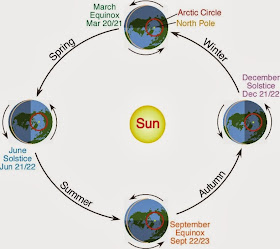We are at just some hours of the new year; the transition between 2013 and 2014. How many hours? well it depends on where you are.
This new year marks that the Earth has complete a complete orbit around the Sun, also known as Julian year. We all know that the time for the Earth to complete an orbit around the Sun is not exactly 365 day, but 365.25 days and the accumulation of the difference creates the leap year. However, most of us do not know that there are other definitions of year, such as sidereal year, tropical year or the lunar year and other years based on certain stars. In the present blog I will just introduce the most common solar years.
Sidereal year
A sidereal year is the time taken by the Earth to orbit the Sun once with respect to the fixed stars. Hence it is also the time taken for the Sun to return to the same position with respect to the fixed stars after apparently travelling once around the ecliptic. It was equal to 365.256363004 SI days at noon 1 January 2000 (J2000.0). This is 6 hours and 9.1626 minutes longer than the standard calendar year of 365 SI days, and 20m24.5128s longer than the mean tropical year at J2000.0. It is important to note that Carl Friedrich Gauss also estimated this year and proposed a duration of 365.2568983 days. Nevertheless, the duration 365.256363004 days was assumed as the standard duration of the sidereal year, while the duration 365.2568983 days was denoted as the Gaussian year. The word "sidereal" is derived from the Latin sidus meaning "star"
Tropical year
A tropical year (also known as a solar year), for general purposes, is the length of time that the Sun takes to return to the same position in the cycle of seasons, as seen from Earth; for example, the time from vernal equinox to vernal equinox, or from summer solstice to summer solstice. Because of the precession of the equinoxes, the seasonal cycle does not remain exactly synchronized with the position of the Earth in its orbit around the Sun. As a consequence, the tropical year is about 20 minutes shorter than the time it takes Earth to complete one full orbit around the Sun as measured with respect to the fixed stars (the sidereal year).
Sidereal year
A sidereal year is the time taken by the Earth to orbit the Sun once with respect to the fixed stars. Hence it is also the time taken for the Sun to return to the same position with respect to the fixed stars after apparently travelling once around the ecliptic. It was equal to 365.256363004 SI days at noon 1 January 2000 (J2000.0). This is 6 hours and 9.1626 minutes longer than the standard calendar year of 365 SI days, and 20m24.5128s longer than the mean tropical year at J2000.0. It is important to note that Carl Friedrich Gauss also estimated this year and proposed a duration of 365.2568983 days. Nevertheless, the duration 365.256363004 days was assumed as the standard duration of the sidereal year, while the duration 365.2568983 days was denoted as the Gaussian year. The word "sidereal" is derived from the Latin sidus meaning "star"
Tropical year
A tropical year (also known as a solar year), for general purposes, is the length of time that the Sun takes to return to the same position in the cycle of seasons, as seen from Earth; for example, the time from vernal equinox to vernal equinox, or from summer solstice to summer solstice. Because of the precession of the equinoxes, the seasonal cycle does not remain exactly synchronized with the position of the Earth in its orbit around the Sun. As a consequence, the tropical year is about 20 minutes shorter than the time it takes Earth to complete one full orbit around the Sun as measured with respect to the fixed stars (the sidereal year).
Image 1. Tropical year of the Earth. Annual change in the position of the Earth around the Sun
Source: Physicalgeography
References & further readingThe Solar and Sidereal year
Tropical year

ReplyDeleteIt's always a pleasure to read your magnificent articles on this site.
You are among the top writers of this generation, and there's nothing you can do that will change my opinion on that.
My friends will soon realize how good you are!
my web page; 오피사이트
(jk)